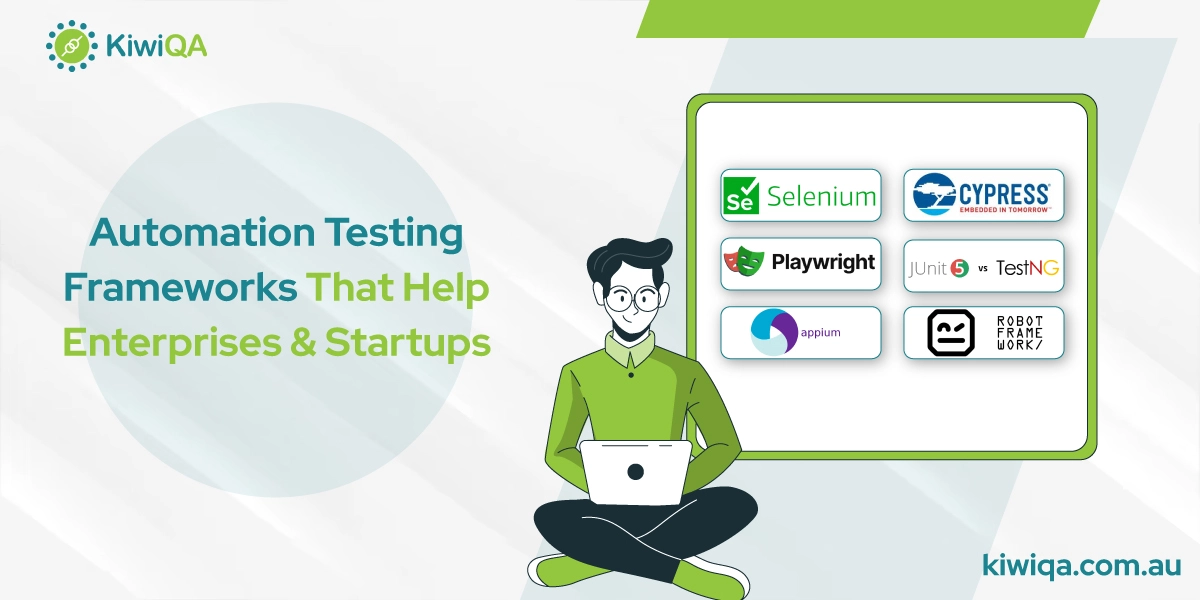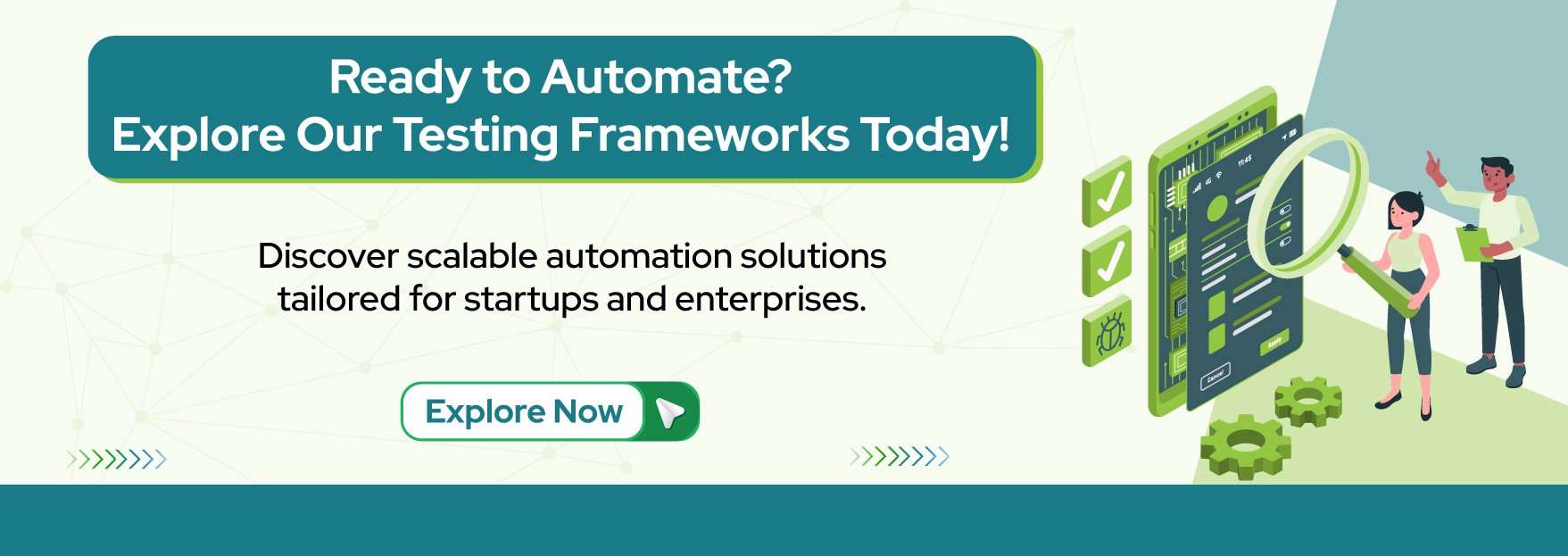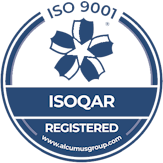Automation Testing Frameworks That Help Enterprises & Startups

Today, delivering quality software is necessary to stay competitive. Even though manual testing is essential, relying completely on that can sometimes become inefficient, prone to error & time-consuming. That’s when QA automation plays a strong role. It offers businesses a streamlined, accurate approach to maintain software quality. The automation testing market is expected to reach USD 55.2 billion by the end of 2028.
Product management is necessary for both startups & larger enterprises. However, the types of frameworks integrated may differ because of variations in organizational size, structure & resources. Automation testing frameworks help to evaluate the bugs, ensure software quality & limit the manual testing effort. This is a cost-effective approach where manual testing struggles with repetitive tasks, automation frameworks improve productivity by speeding up the tasks & cost-cutting.
The QA team uses frameworks such as Selenium, Playwright, etc., for automating the test case & boosting execution. It approaches faster issue detection & improvement that ultimately increases the time to market. The following blog is dedicated to defining the Automation Testing Service and how the testing framework supports startups & enterprises.
One of the biggest benefits of mobile automation testing frameworks is the capacity to execute tests quickly and repeatedly. Teams may complete thorough testing in a fraction of the time needed for manual testing methods thanks to automated tests that can run constantly without human intervention. This offers faster deployment, lower development costs, and increased project efficiency. In agile development contexts, where frequent releases and revisions are the norm, this speed is especially important.
Manual testers must prioritize test cases and have a limited amount of time to conduct tests due to financial and time constraints. A QA automation testing services team may expand test coverage and check more test cases thanks to test automation. Additionally, when regression tests are properly automated, manual testers are free to focus on other important duties during routine procedures.
For instance, when a new version of an application goes into production, they don’t have to manually repeat tests because the tests run automatically. Additionally, automation testing service senhance test accuracy and limit manual mistakes. With automation, you can be sure that every stage of a test scenario will be carried out accurately and completely in accordance with product documentation and business needs.
It is simple to extend automated test suites and run them concurrently in various environments, browsers, and devices. In order to ensure that testing can grow with the application, this parallel execution capability is essential for testing applications that must support a wide range of user bases and system settings.
 Key Features of an Effective Automation Framework
Key Features of an Effective Automation FrameworkA crucial component of successful frameworks used in automation testing is modularity. Organizations can minimize effort duplication and achieve component reusability by structuring the architecture in a modular fashion. Organizations can divide complicated automation procedures into smaller, more manageable pieces because of modularity.
This effectively makes it possible for separate automation modules to be developed, maintained, and tested independently, increasing productivity and lessening the influence of updates or modifications on the framework as a whole. In addition to encouraging teamwork and an innovative culture, modularity speeds up the creation and implementation of automation solutions by allowing various teams to work on different modules at the same time.
Different frameworks in automation testing architecture must be flexible in order to adjust to evolving business needs. Companies like yours need to adopt new technologies and incorporate them with different platforms, tools, and systems. Therefore, you should design an architecture that is compatible with these technologies and systems.
The framework’s adaptability allows it to accommodate many automation techniques, including ML, AI, and robotic process automation (RPA). Additionally, it enables organizations to stay at the forefront of automation breakthroughs by utilizing emerging technology as it becomes available.
Jenkins, GitLab CI/CD, GitHub Actions, Azure DevOps, and other popular CI/CD platforms should all be easily integrated with the framework. This frequently entails offering unambiguous documentation, plugins, or straightforward command-line interfaces for initiating pipeline testing.
First and foremost, scalability is an essential component of frameworks used in automation testing, guaranteeing that it can manage rising demands and workloads without sacrificing stability or performance. By putting in place scalable infrastructure and components, organizations may safeguard their framework and manage large-scale tasks. Additionally, scalability guarantees that automated processes may scale up or down in accordance with your company’s needs, allowing organizations to deploy resources efficiently.
Evaluating the efficacy and performance of automated processes requires extensive monitoring and reporting capabilities. To find faults, bottlenecks, and opportunities for framework optimization, automation framework architecture should incorporate real-time monitoring, logging, and analytics.
IT executives can make data-driven decisions for ongoing improvement by using monitoring and reporting to see how well automation processes are functioning. These features assist companies in proactively identifying and resolving problems, streamlining automation processes, and improving the general effectiveness of their automation projects.
Also Read: The Future of Software Delivery AI-Driven Automation Testing Processes
The record-and-playback framework is another term you can use to define the best automation testing frameworks 2025. It is not scalable or reusable, and is not good for enterprise project testing. This type of framework is a good choice for small projects with straightforward workflows. It is well-liked for creating tests quickly, where less coding is required. Nevertheless, it is challenging to maintain for complicated applications and lacks adequate scalability.
A straightforward technique for automatically validating and checking applications is linear automation. Tests run one action at a time in a preset sequence. They can then automatically run the tests by replaying these recorded steps. It’s a useful method for evaluating how well an application’s interactive and visual components work. Some common benefits are-
Module-based testing, one of the popular types of frameworks in automation testing, is a method that creates test cases using abstract models. Rather than checking the code directly, the requirements of system behavior are the main focus. The model is made to represent the features that the app should perform.
You can run test cases using this model to determine whether the program satisfies these specifications. Instead of being weighed down by massive code bases, you can concentrate on how your software should function. Some common benefits are-
All required inputs and anticipated outcomes are stored in data files when using a data-driven test automation framework. This facilitates the execution of all test cases with various data sets. It is possible to write driver scripts that can read data files and browse the entire application.
The overall amount of test scripts required to implement every test case can be greatly decreased using data-driven test automation. It is possible to compile test data far in advance of test configuration and execution. More flexibility for maintenance and bug fixes is also made possible by this kind of architecture. Some common benefits you can expect are-
This framework uses self-descriptive keywords that live with sets of data tables and is not dependent on any particular application. This is usually an expansion of the framework type that is data-driven. The approach performs a series of activities using predetermined keywords.
One or more sets of requirements that the test must meet are included in each keyword. Test development and test design can be kept apart with this method. It works well for projects with non-technical testers who must generate tests without knowing how to program, applications with continuous UI changes, and legacy systems. Some common benefits are-
Keywords & data-driven practices could be used in a hybrid testing framework. As the application is assessed using changeable data sets, this facilitates the comprehension of testing by non-technical team members. Numerous end-to-end testing techniques have been used in its construction.
As the name suggests, this framework integrates one or more of the aforementioned automation frameworks, making use of their benefits while trying to reduce their drawbacks. Because every application is different, the testing procedure for these apps needs to be different. Additionally, a hybrid framework makes it possible for testers to be more adaptable and quicker in order to generate better test outcomes. Some benefits of this framework are-
Selenium is a free-to-use framework for browser and online application automation. Its vast library and tools are used by testers to develop scripts in a number of popular computer languages. These scripts carry out user-like tasks and allow interaction with web elements. Software testing procedures can be made more efficient and reliable with the use of automation testing frameworks like Selenium.
These frameworks enable the creation of automated test scripts that can mimic user interactions with web applications, assisting in the systematic and repetitive identification of defects, performance issues, and other potential problems. Selenium and comparable automation testing frameworks contribute to faster release cycles and higher overall software quality by automating repetitive and time-consuming testing processes.
Test-driven development (TDD) is made possible for developers with Cypress, a developer-centric test automation framework. The idea behind its design was to make the complete end-to-end testing process easy and enjoyable by packaging and bundling everything together. Cypress operates inside the browser, but Selenium WebDriver operates remotely outside of it. In order to provide more reliable findings, this method supports comprehending everything that occurs both inside and outside the browser.
It gives you native access to all objects without asking to deal with storage & protocols. As you drag your application into the browser, Cypress can synchronously alert you of anything that occurs inside the browser, giving you native access to every DOM element. Additionally, it makes it simple to incorporate a debugger into your program, which facilitates the use of the developer tools.
Playwright is an emerging framework for automated testing that has gained recognition for its exceptional abilities in online utility testing. It focuses on providing a single browser automation solution across multiple browsers, including WebKit, Firefox, and Chromium.
Playwright sets itself apart by offering a single API that eliminates the need to maintain distinct codebases for every browser, simplifying the testing process and increasing productivity. Another notable feature of Playwright is its support for browser contexts, which enables the simulation of several browser instances within a single test script. Through the DevTools Protocol, it offers APIs for managing headless or complete browsers.
An open-source best automation testing framework 2025 for unit testing called JUnit can be easily incorporated into a variety of software testing techniques. It allows the creation and execution of repeatable tests more easily for specific code segments. JUnit strives to improve code stability, productivity, and quality. It is based on the TDD methodology, so it is easier to find loopholes prior to development.
TestNG, powered by JUnit, is a Java testing framework. But it has some fantastic new features that boost its scalability and potential. It can be used for several sorts of testing, such as functional, security, and integration. One of the best Java test frameworks, TestNG, is well-known for its sophisticated features, especially when a large number of test cases need to be executed.
The success of Appium, a widely used top automation testing framework 2025 for mobile application testing, can be attributed to several compelling factors. Appium is a cross-platform, free-to-use framework that facilitates automation testing for iOS/Android, making it extremely useful for mobile app developers and testers.
The creation of consistent and reusable test scripts is made possible by Appium’s cross-platform interoperability, which lessens the effort needed to maintain separate test suites for iOS and Android. Furthermore, Appium offers flexibility for development teams with different language preferences by supporting other programming languages, such as Java, Python, C#, and Ruby. It serves as a bridge between the test code and the device or emulator, converting commands supplied by the test script into platform-specific calls.
If you wish to use a Python framework for test automation, Robot Framework is the best option. Although the Robot Framework is based on Python, you can alternatively utilize IronPython (.NET) or Jython (Java). The Robot Framework allows easy test development by utilizing keyword-driven practices.
Numerous test libraries, such as the Selenium WebDriver library and other helpful tools, are included. To make it as extensible as feasible, it offers a large number of APIs. For testers who have already integrated other keyword-based tools, this is the best tool.
Large businesses are distinguished by their sophisticated organizational structures, vast resources, and well-established procedures. In businesses, product management involves navigating these challenges while guaranteeing congruence with strategic objectives and providing value at scale.
To guarantee uniformity, compliance, and risk management, businesses frequently have clearly defined procedures and governance frameworks. Businesses usually need frameworks that can manage complicated, large-scale applications with numerous integrations, emphasizing long-term maintainability and teamwork.
Small scale, limited assets, and a high level of uncertainty are common characteristics of startups. They work in a dynamic setting where survival and expansion depend on quick iteration and adaptability. To react swiftly to shifts in the market and consumer input, startups need to be extremely adaptive and versatile.
Because they emphasize iterative development, ongoing feedback, and quick adaptation, agile and lean approaches are especially well-suited for startups. Startups focus on the rate of execution, flexibility to react to rapid modifications, and affordable solutions to accomplish a fast time-to-market and build a market presence.
Also Read: How to Choose the Right Automation Testing Services Partner in Australia?
The automated framework you choose must be straightforward to comprehend. Divide complicated tests into more manageable, reusable components. This facilitates the comprehension, upkeep, and reuse of code snippets. Give variables, methods, and test cases meaningful names.
Make an automation plan first. This acts as the roadmap for future testing & allows you to evaluate the test case needs to automate. You should first decide which kinds of tests to automate and specify your automated testing objectives. Each of the several forms of testing has a specific role in the testing procedure.
Test automation services require the choice of an automated testing technology. There are several automated testing solutions available, and it’s critical to select the one that best meets your overall needs. The testing tools you use will depend on your application.
For instance, you may create end-to-end automated test suites for web applications using tools like Selenium, Cypress, and Playwright. For mobile applications, you can also utilize Espresso or Appium. When choosing a tool, be sure to examine its functions, community support, and maintenance status.
Use design patterns like Page Object Model, adhere to essential principles, and preserve tests’ simplicity and independence to keep automation tests readable and manageable. Divide the framework into modules, handle data externally, and provide good documentation.
In order to produce high-quality software quickly and effectively in 2024, automation testing must be incorporated into CI/CD pipelines. Automation testing acts as a checkpoint in the CI/CD pipeline, making sure that code modifications satisfy the necessary quality standards before moving forward. It enables faster iterations and gives developers timely feedback by automating the execution of different kinds of tests.
An automation framework’s long-term efficacy, scalability, and maintainability depend on ongoing evaluation and improvement. This entails keeping an eye on KPIs, getting input, and putting optimization techniques into practice. Monitor test stability over time. Assess the effectiveness of the automated tests in identifying bugs before they are put into production.
 Ready to Elevate Your Testing Game? Let’s Find the Right Framework Together
Ready to Elevate Your Testing Game? Let’s Find the Right Framework TogetherAutomating software testing is the best way to drive the project’s effectiveness & efficiency. To get the best benefits, you must have the right set of automation testing frameworks. Since every project is unique, the duration, requirements, and selection of tools can vary. Your primary goals should be selecting an automation framework that leads to productivity and impressive results. Apart from the technical features, the QA partner you choose should offer access to 24/7 support.
The testing tool should drive the testing effectiveness & empower the team to deliver a quality product. If you want to start your testing journey but are unable to decide from where & how to start, hire an automation testing company & ask them to evaluate your business setup & challenges. They will evaluate your project & determine the best practices that suit your vision. Hope this guide helps you to choose the best framework for your project.
Subscribe to our newsletter for some hand-picked insights and trends! Join our community and be the first to know about what's exciting in software testing.
Welcome to the testing tales that explore the depths of software quality assurance. Find valuable insights, industry trends, and best practices for professionals and enthusiasts.

Fill out and submit the form below, we will get back to you with a plan.
 CRN:
22318-Q15-001
CRN:
22318-Q15-001 CRN:22318-ISN-001
CRN:22318-ISN-001 CRN:22318-IST-001
CRN:22318-IST-001